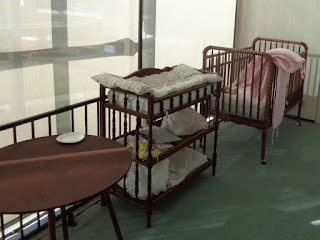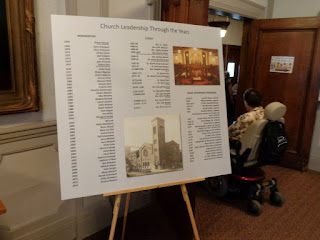This month we're visiting churches
that are featured in movies, so it seems reasonable to first deal with expectations
raised by viewing the movie. This week's church was used as a location for the
Robin Williams film "License to Wed." Here are three things found in
the film which we didn't find at the actual church:
1) The pastors are not wildly antic
stand-up comedians. Yes, I know that some may find such clergy appealing, but
do you really want your pastor making zany asides about your mother's liver
disease? Senior Minister the Rev. Elena Larssen and Associate Minister the Rev. John Forrest Douglas
seemed to be quite pleasant and kind, both with a decent sense of humor, but
neither seemed destined to be opening at the
Improv any time soon.
2) Late comers were not shamed. In
the film, Williams interrupts his own prayer to note that the couple under his
premarital counseling is late for church. The choir sings a special little
"
you're late" song reminiscent of the white rabbit in "
Alice in Wonderland." When we were at this church, anyway, late comers entered in
peace. Shaming people for any reason would be at odds with the middle part of
the
church motto: "A Liberal Church, Welcoming of All, Passionately
Committed to Social Justice."
3)
St. Augustine's Church in the
film is quite nebulous about its denominational affiliation, whereas First
Congregational is clear about its
denominational affiliation, proud of their
descent from the Pilgrims. In a conversation with folks before church, there
were several mentions (usually jovial) of someone or other being a "good
Congregationalist" and the denomination received a few hat tips during the
service.
We arrived half an hour before the
service and a number of people welcomed us and someone directed me to a church
timeline filling a wall in the fellowship hall ("Koinonia Room"). The
display had been set up the previous year in celebration of the church
building's hundredth anniversary. There were a number of interesting entries
through the years (I was amused by a mention of a petition early in the 20th
century against billiards and pool tables, and was interested to see the church's
proclamations against Hitler in the early 1930's).
The timeline noted television shows
that been filmed at the church, including
Ally McBeal and
Criminal Minds. A
gentleman named Chan told me that
American Horror Story had recently done
location filming there. Chan had been serving as church secretary when Ally
McBeal filmed, and said that everything that might interrupt filming had been
removed then, except the church's answering machine.
I asked Chan how long he had been
attending the church. He said he and his partner first came to the church in
1987. He believed they might have been
the church's first openly gay couple. (I noticed that the timeline included the
church's participation in a Gay Pride parade in 1985.) Chan said he believed a
third of the church was gay or lesbian, though someone else thought half would
be more accurate. (Another gentleman, Ben, told Mindy that the official figure
is 43%.) Chan and Ben both mentioned that the associate minister is gay (which the
church's website also mentions). A number of people we talked to said that the
church's welcoming nature is what first appealed to them.
The service opened with the sound of
a Buddhist singing bowl and the progression of the choir in their robes to the
front of the sanctuary. (Mindy noticed the organist in shorts providing a nice
casual contrast to the choir and clerical robes.) During the service, the choir
that day sang a
Randy Stonehill song from the eighties, "
Shut de Do'."
(In the
weekly church newsletter, the choir director said of the song, "What
strikes me is that the only thing required to keep the devil at bay, in the
words of this week's anthem, is a door that is kept shut. The door, of course,
is just as figurative as the devil ... but sometimes an actual door or two can
make a difference."
)
The church was beginning the annual stewardship
drive, which I had heard people talking about before the service. During the
"Stewardship Moment", a member of the congregation urged people to
consider the benefit the church provided by offering opportunities to
volunteer.
The Drop-In Center provides
meals for the homeless, and a number of students have used this as an opportunity
to meet requirements for volunteer hours. Other groups have served at the
center, including Hindu, Muslim and Jewish organizations.
The DAYS Program
provides language and math tutoring for schoolchildren.Volunteering for these
programs, the speaker noted, made people "feel better about themselves."
The prayer time was introduced as a
"moment to take a deep breath." The conclusion of the prayer was not, as is
common in churches, in Jesus' name, but rather "we pray this in your many
names." (There is a reason we honor the name of Jesus above all others. In
Philippians 2, Paul wrote,
"Therefore God exalted him to the highest place and gave him the name that
is above every name, that at the name of Jesus every knee shall bow, in heaven
and on earth and every tongue acknowledge that Jesus Christ is Lord, to the
glory of God the Father."*)
Rev. Douglas gave the sermon, using
Mark 12:41-44 (where a widow donated all she had, two small coins, to God's
service) as his starting point. He began by telling the story of "
The Lion King," saying that just as Simba believed Scar's lies, we tell ourselves
lies. We say, "I'm not smart enough" or "I'm not good enough for
that job." But, he said, the widow's story teaches us that "YOU ARE
ENOUGH."

The thing is, though we sometimes
tell ourselves untrue and negative messages, sometimes we're not smart enough.
That's why
Harvard didn't come begging me to take their scholarship money. And
I'm not up to the job of center for the
Golden State Warriors. Those who use a
twelve-step program to deal with their addictions admit regularly that by
themselves, they're not enough to deal with their cravings. And I'm not good
enough for salvation without the grace that comes through Christ's death on the
cross. I'm not enough, but Jesus is.
All of this made me rather sad this
week. You see, as we've visited various churches, we obviously encounter
beliefs and practices that differ from our own.
We usually consider these minor things. But this church, in an article
explaining their liberal theology, states that for most who are part of the
church, "Jesus is not a divine figure sent from God to pay for the sins of
a fallen humanity." In the Bible, 1 John 4:2 -3 reads, "This is how
you can recognize the Spirit of God: Every spirit that acknowledges that Jesus
Christ has come in the flesh is from God but every spirit that does not
acknowledge Jesus is not from God."
We really liked the kind people we
met at this church, and they serve their community in fine ways. But salvation
through Jesus Christ is heart of the Christian gospel. As
C. S. Lewis famously argued, Jesus was the Lord, a liar or a lunatic. This church wishes to honor
Jesus as a good teacher, but He didn't leave us that option.
*Philippians 2:9-11, NIV
Statistics:
Service Length: 1 hour 16
minutes
Sermon Length: 13 minutes
Visitor Treatment: "Passing
the peace" was a warm greeting time during the service, and several people
greeted us as we walked around before worship began. Each pew had an attendance
form that all were encouraged to use to register their attendance.
Followup by Tuesday Morning:
Welcoming email on Monday afternoon (from the Associate Minister)
Our Rough Count: 145
Probable Ushers' Count: 175
Snacks: coffee, tea and hot
chocolate in the courtyard; cookies, fruit and other treats available in the
Koinonia room for a donation to the Outreach and Social Justice committee
Musicians: organist/bongos
(male), choir director/maracas (male), rhythm sticks (male), full choir (forgot
to count, but probably about 15-20 men, 15-20 women), youth bell choir (about
10 middle school aged students), guitar (male) and percussion box (male) for a
special song
Songs: organ, "Prelude
on 'Borning Cry'"
"We
Sing Because"
"Song
of Welcome"
bell
choir, "A Festive Intrada"
"I
Was There to Hear Your Borning Cry"
choir,
"Shut de Do'"
special
music, "It's Just Leaving"
"There's
a Spirit in the Air"
organ,
"Diptych (based on 'Orientis Partibus')"
"Doxology"
"What
a Covenant"
organ
postlude (which people stayed for) "Trumpet Toccata"
Miles to place: 498
Total California Miles: 15,624






























































